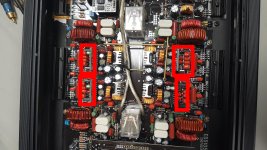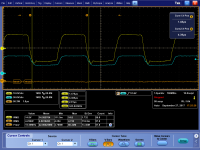I have one of the monster elemental design nine.5 amps. It appears to be functioning for the most part, but there are two things that have me concerned. At idle with a 13.8V supply, the amp pulls 3.4 amps. This is higher than what I usually see with most amps, but since this is a 5 channel amp I cannot really say if that is about normal or not. The remote line also pulls 50mA at startup, then settles down to 17mA. This is also higher than most amps I have worked on. Neither are obvious problems to me, but it caught my attention. Can anyone confirm if those values are correct?
Second question has to do with some component temperatures. The amp uses 4 pairs of (I'm assuming) drivers. I think these are for each of the 4 main channels, but I am not completely sure of that. The reference designators are Q101/102, Q201/202, Q301/302, and Q401/402. They are are BD139-10 and BD140-10 pair. When I use my thermal camera, these components get really hot at around 100C. It does not seem to matter if it is at idle or at load, but they are lighting up hot. Is that normal for this design or if not where would I be looking? It seems odd that if there was an issue that all four pairs would all have issues because they seem fairly independent based on channel.
I have included a highlighted picture of the location of these components.
Second question has to do with some component temperatures. The amp uses 4 pairs of (I'm assuming) drivers. I think these are for each of the 4 main channels, but I am not completely sure of that. The reference designators are Q101/102, Q201/202, Q301/302, and Q401/402. They are are BD139-10 and BD140-10 pair. When I use my thermal camera, these components get really hot at around 100C. It does not seem to matter if it is at idle or at load, but they are lighting up hot. Is that normal for this design or if not where would I be looking? It seems odd that if there was an issue that all four pairs would all have issues because they seem fairly independent based on channel.
I have included a highlighted picture of the location of these components.
Attachments
The only notes I have from the only one I've seen is 3.75 amps at idle.
The drivers appear to have a brown tint in the photos I have which is often an indicator that they've run hot.
The drivers appear to have a brown tint in the photos I have which is often an indicator that they've run hot.
What is the fundamental parameter indicating that the component is fast enough to operate at that particular switching frequency?The only notes I have from the only one I've seen is 3.75 amps at idle.
The drivers appear to have a brown tint in the photos I have which is often an indicator that they've run hot.
I would say, this is a full-range D-class amplifier, the switching frequency of each channel will be around 250 / 300khz (to allow full-range operation).
BD139 and BD140 are fast enough to fulfill this job?
I would never have thought, but I would use d44vh10 and d45vh10 (specific for switching and high current applications).
Am I wrong?
What is the fundamental parameter indicating that the component is fast enough to operate at that particular switching frequency?
I would say, this is a full-range D-class amplifier, the switching frequency of each channel will be around 250 / 300khz (to allow full-range operation).
BD139 and BD140 are fast enough to fulfill this job?
I would never have thought, but I would use d44vh10 and d45vh10 (specific for switching and high current applications).
Am I wrong?
I think only the sub channel is class D. I think the 4 channel full range section is class A/B. If this really is a full range class D, then the amp chassis seems about 400% oversized and the full range section is very inefficient. I think the drivers we are talking about are for a class A/B section.
if i'm not wrong, the Elemental Designs eD Nine.5 is a FIVE Channel amplifier, all channel are in class D.I think only the sub channel is class D. I think the 4 channel full range section is class A/B. If this really is a full range class D, then the amp chassis seems about 400% oversized and the full range section is very inefficient. I think the drivers we are talking about are for a class A/B section.
4 CHANNEL for mids and highs ( with t130-2 micrometals toroids) and one channel (the bigger) for subwoofer (with bigger toroid).
The 4 channel (for mids and highs) operate with a 250/300khz switching frequency; the channel for sub, operate with a tipical 100khz switching frequency.
if i'm not wrong, the Elemental Designs eD Nine.5 is a FIVE Channel amplifier, all channel are in class D.
4 CHANNEL for mids and highs ( with t130-2 micrometals toroids) and one channel (the bigger) for subwoofer (with bigger toroid).
The 4 channel (for mids and highs) operate with a 250/300khz switching frequency; the channel for sub, operate with a tipical 100khz switching frequency.
Looks like you are right. I should have taken a closer look when I was in there and not just assumed. Looks like each channel does have its own driver. The fact remains though that I'm not sure if what I'm looking at is correct for OEM or if something is wrong. I have included a picture of the base of the BD139 and the gate of the corresponding output with the amp just idling. Looks like about 340khz switching frequency. Keep in mind both scope probes are referenced to earth ground, so that is why there might be an offset.
Attachments
Last edited:
So anyone else able to confirm what the OEM transistors are or if everything looks normal? I understand it may not be the best design, but if it is original I can live with it.
The idle current draw is normal for me, but maybe bd139 and bd140 run hot for two reason.So anyone else able to confirm what the OEM transistors are or if everything looks normal? I understand it may not be the best design, but if it is original I can live with it.
IMHO, they have too little driver capacity and are too slow for Full range class D application.
As I mentioned in my post above, I would have used couples d44vh10 and d45vh10 (unfortunately however, they have the connecting pins in a different order), if you feel like making an adaptation, then you can do it.
The idle current draw is normal for me, but maybe bd139 and bd140 run hot for two reason.
IMHO, they have too little driver capacity and are too slow for Full range class D application.
As I mentioned in my post above, I would have used couples d44vh10 and d45vh10 (unfortunately however, they have the connecting pins in a different order), if you feel like making an adaptation, then you can do it.
Thanks. I will look into it. If I just have to flip around a TO-220 because of the base/collector/emitter configuration that would be easy. It looks like the lead spacing is slightly different though so it might be more difficult to fit that in.
I am still trying to find out if the BD139/140 is OEM or not.
For options that are the same case as the BD139/140, what about the MJE172/182?
Last edited:
probably, BD139,140 are OEM components, but this is one of the major causes of premature burning of the amplifiers in the original state (mount originally, components that are meant to make a bad end) otherwise there would be no recirculation of money to repair them.Thanks. I will look into it. If I just have to flip around a TO-220 because of the base/collector/emitter configuration that would be easy. It looks like the lead spacing is slightly different though so it might be more difficult to fit that in.
I am still trying to find out if the BD139/140 is OEM or not.
For options that are the same case as the BD139/140, what about the MJE172/182?
BD139 And BD140, will warm today, will heat tomorrow, maybe even for a long time, but will be destined to die.
MJE172 AND MJE182 are already much better, they are used in D class subwoofer amplifiers, where the switching frequency is equal to or slightly over 100khz, without any problem, but looking at the datasheet, it seems that they can be yours.
- Status
- Not open for further replies.
- Home
- General Interest
- Car Audio
- Elemental Designs eD Nine.5 Questions

